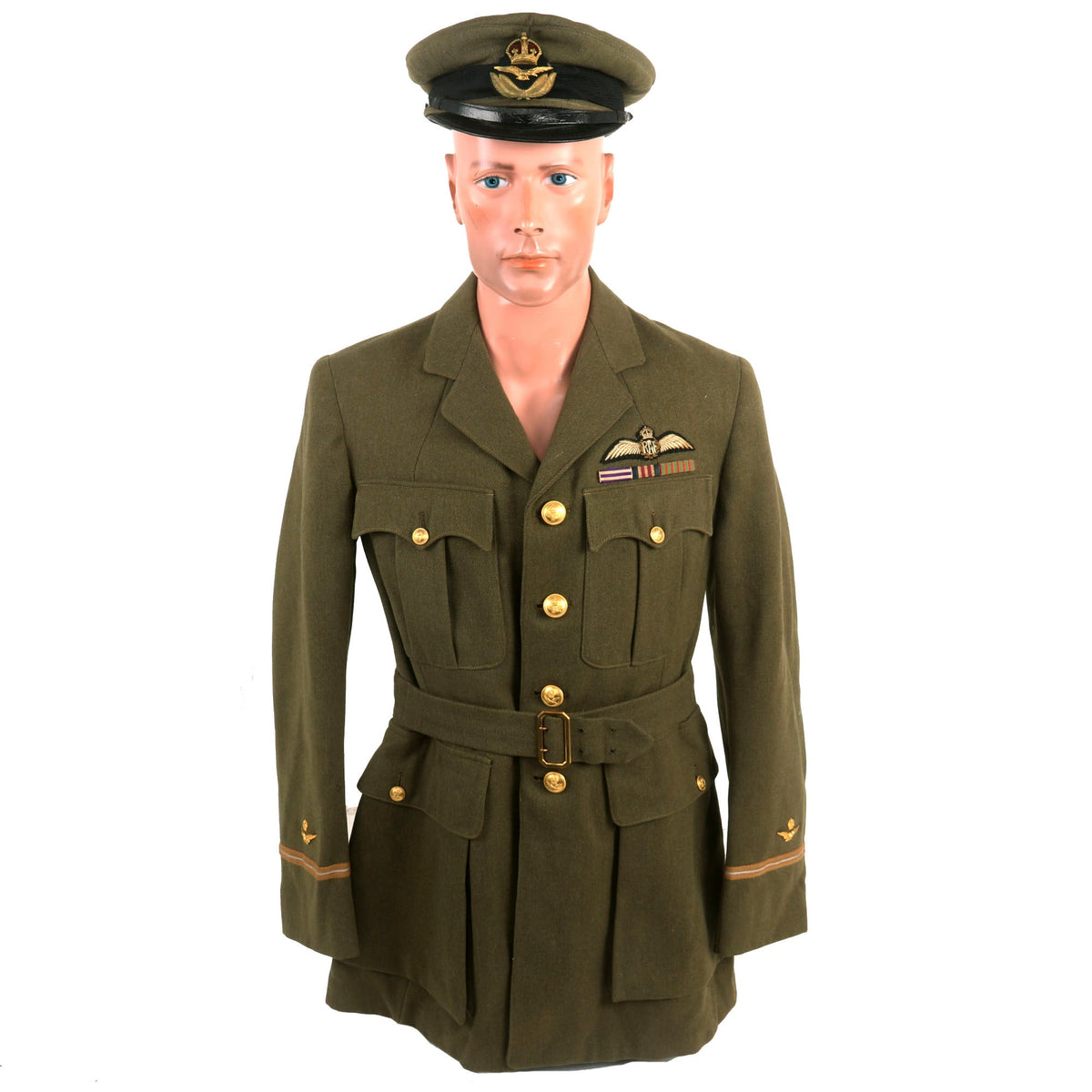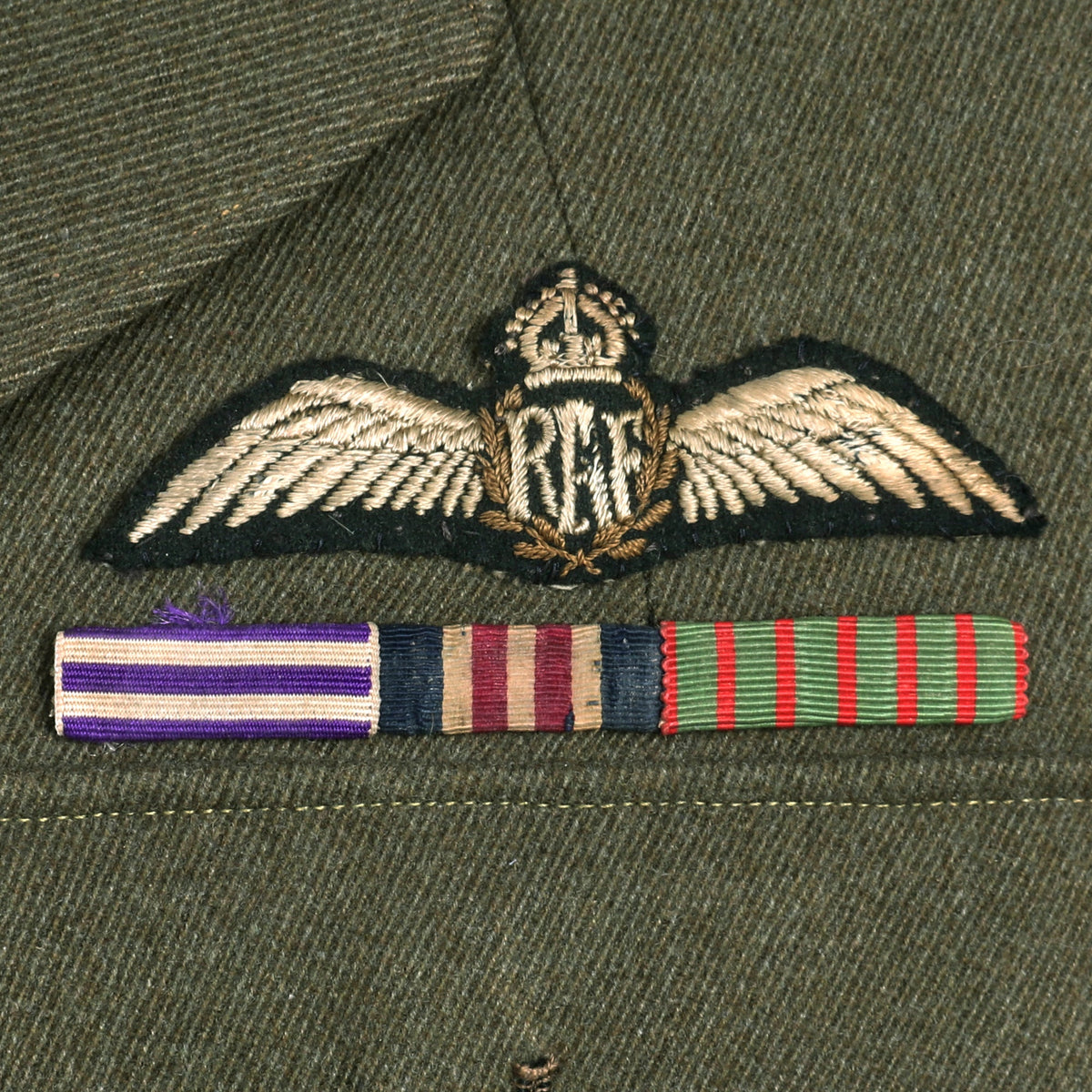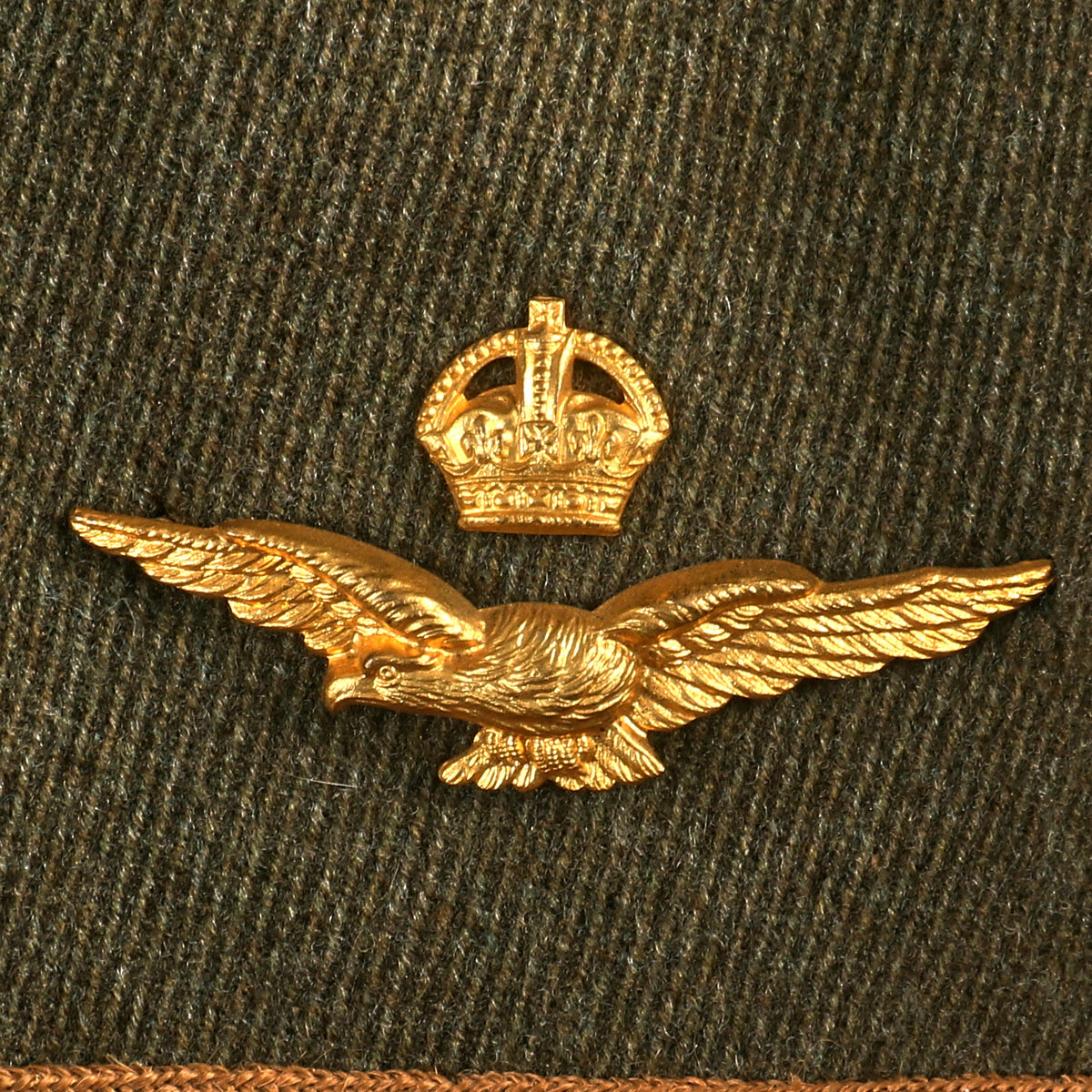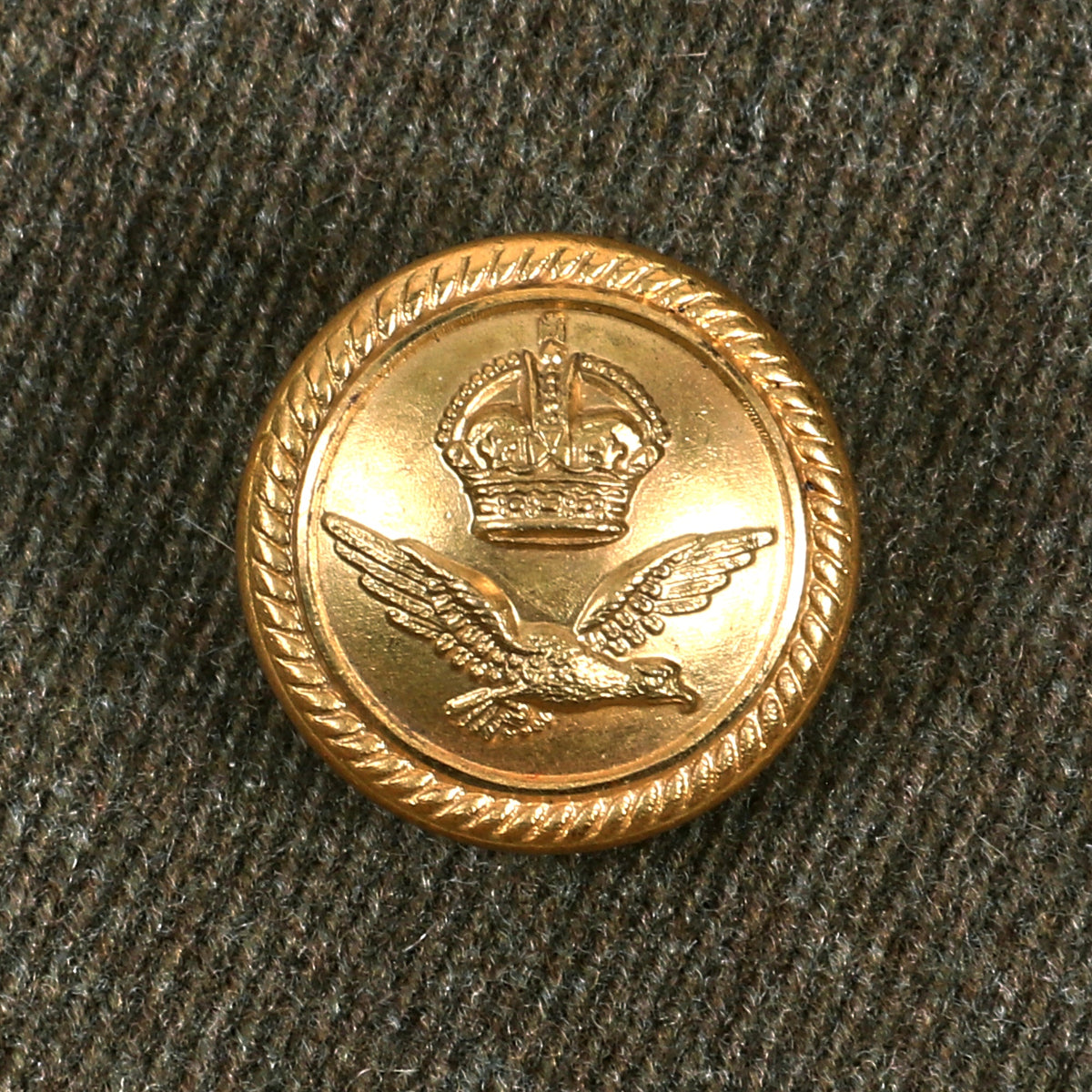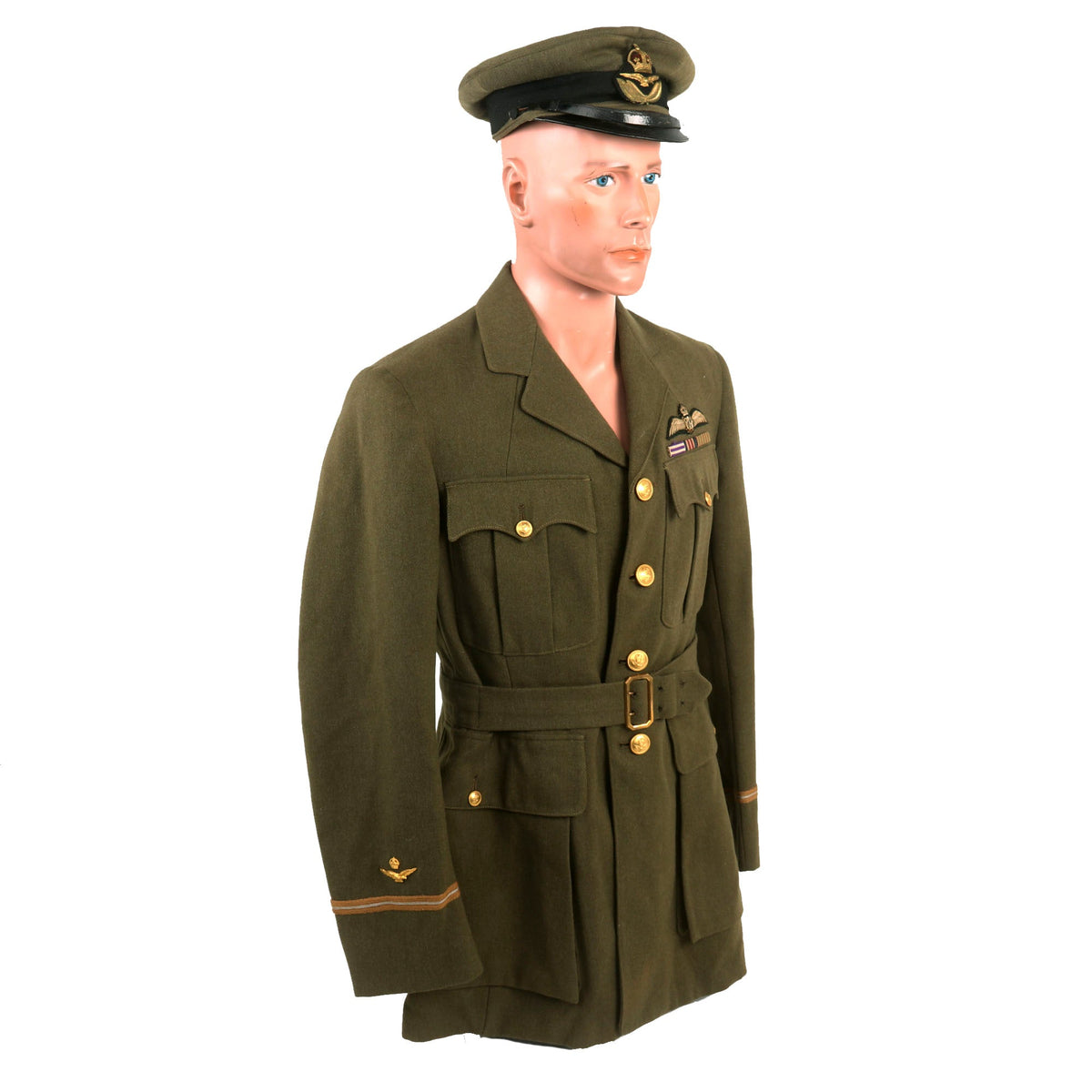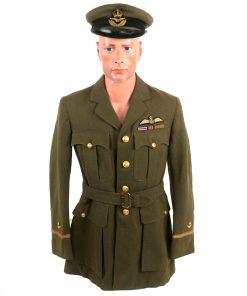Original British WWI 1918 Royal Air Force Uniform Jacket For Lieutenant Reginald Cyril Byass With Peaked Visor Original Items
$ 3.795,00 $ 948,75
Original Items: Only One Set Available. Now this is a great example of an incredibly rare “Interim” pilot’s uniform for the Royal Air Force, dated October 18th, 1918! The khaki Service Dress tunic adopted for the Royal Flying Corps (RFC) in 1912 had a wide cloth panel (a plastron) across the chest with concealed buttons, since it was thought that the usual button arrangement would be liable to catch on the bracing wires used on aircraft at that time. This tunic was popularly known as the “maternity jacket”. The Naval Wing of the RFC, later the Royal Naval Air Service (RNAS), wore naval uniform.
On 1 April 1918, the RFC and RNAS merged to form the Royal Air Force (RAF). Initially, the uniforms of the former services continued in use, but on 1 May, an “interim” RAF uniform was approved which was basically the standard khaki Army Service Dress. A light blue version of Service Dress was approved for daily wear on 10 July, but this proved highly unpopular and many persisted with their old outfits. Finally, on 1 October 1919, the RAF Service Dress of a blue-grey colour, known as Air Force blue, was introduced.
This example of the early RAF Khaki coat is in fantastic condition given the age and the changes it underwent (device wise). The interior it lined with a great brown polished cotton and even retains a 1918 dated cloth label on the back. The tag is for a Morris tailors located at 28a Sackville Street, London, W.1. Sackville Street is a street in central London which today is mainly composed of offices and the rears of retail premises, but once was the home to several important medical figures. 28 Sackville Street was the home of the Sackville Gallery between the two World Wars where the important exhibition of Futurist painting was held in 1912.
The jacket is named to Lieutenant Reginald Cyril Byass, and is dated 18.10.18 (October 8th, 1918) a Pilot whose “Area Served In” is simply listed as being France.
All buttons and insignia are correct for an interim uniform for the transition from the RFC to the RAF. The rank insignia for the uniform can be identified by the bands and insignia on the cuffs. The rank for “gold-blue-gold” is for a Lieutenant. The RAF badge on the left breast is of the earliest “padded” embroidered type and is offered in excellent condition with minor age toning. There are 3 ribbons on the front and are for the Distinguished Flying Medal, Military Medal and Croix de Guerre.
The included visor cap is another rare interim period pilot item. The cap itself is named on the interior top with R. Brodie. While we were unable to fully identify him, we were able to confirm that he was a Pilot (Officer) and served with the RCF into the RAF before being placed on the Unemployment list, the same fate suffered by Lieutenant Byass. The overall condition shows that it served and was worn faithfully for many years without abuse. There is staining, light thread loss on the sweatband and crazing to the visor, but still presents itself wonderfully!
An incredible, named uniform set that comes more than ready for further research and display.
Approximate Measurements:
Collar to shoulder: 10.5″
Shoulder to sleeve: 27”
Shoulder to shoulder: 16”
Chest width: 18″
Waist width: 17.5″
Hip width: 25″
Front length: 34.5″
The Royal Air Force (RAF) is the United Kingdom’s air and space force. It was formed towards the end of the First World War on 1 April 1918, becoming the first independent air force in the world, by merging the Royal Flying Corps (RFC) and the Royal Naval Air Service (RNAS). Following the Allied victory over the Central Powers in 1918, the RAF emerged as the largest air force in the world at the time. Since its formation, the RAF has played a significant role in British military history. In particular, during the Second World War, the RAF established air superiority over Hermann Göring’s Luftwaffe during the Battle of Britain, and led the allied strategic bombing effort.
The RAF’s mission is to support the objectives of the British Ministry of Defence (MOD), which are to “provide the capabilities needed to ensure the security and defence of the United Kingdom and overseas territories, including against terrorism; to support the Government’s foreign policy objectives particularly in promoting international peace and security”. The RAF describes its mission statement as “… [to provide] an agile, adaptable and capable Air Force that, person for person, is second to none, and that makes a decisive air power contribution in support of the UK Defence Mission”. The mission statement is supported by the RAF’s definition of air power, which guides its strategy. Air power is defined as “the ability to project power from the air and space to influence the behaviour of people or the course of events”.
Today, the Royal Air Force maintains an operational fleet of various types of aircraft, described by the RAF as being “leading-edge” in terms of technology. This largely consists of fixed-wing aircraft, including those in the following roles: fighter and strike, airborne early warning and control, intelligence, surveillance, target acquisition, and reconnaissance (ISTAR), signals intelligence (SIGINT), maritime patrol, air-to-air refueling (AAR) and strategic & tactical transport. The majority of the RAF’s rotary-wing aircraft form part of the tri-service Joint Helicopter Command in support of ground forces. Most of the RAF’s aircraft and personnel are based in the UK, with many others serving on global operations (principally over Iraq and Syria) or at long-established overseas bases (Ascension Island, Cyprus, Gibraltar, and the Falkland Islands). Although the RAF is the principal British air power arm, the Royal Navy’s Fleet Air Arm and the British Army’s Army Air Corps also operate armed aircraft.
Fast Shipping with Professional Packaging
Thanks to our longstanding association with UPS FedEx DHL, and other major international carriers, we are able to provide a range of shipping options. Our warehouse staff is expertly trained and will wrap your products according to our exact and precise specifications. Prior to shipping, your goods will be thoroughly examined and securely secured. We ship to thousands clients each day across multiple countries. This shows how we're dedicated to be the largest retailer on the internet. Warehouses and distribution centres can be located throughout Europe as well as the USA.
Note: Orders with more than one item will be assigned a processing date depending on the item.
Before shipping before shipping, we'll conduct a thorough inspection of the items you have ordered. Today, the majority of orders will be delivered within 48 hours. The delivery time will be between 3-7 days.
Returns
The stock is dynamic and we cannot completely manage it because multiple stakeholders are involved, including our factory and warehouse. So the actual stock may alter at any time. It's possible that you may not receive your order once the order has been made.
Our policy is valid for a period of 30 days. If you don't receive the product within 30 days, we are not able to issue a refund or an exchange.
You can only return an item if it is unused and in the same state as the day you received it. You must have the item in its original packaging.
Related products
Uncategorized
Armored Burgonet Helmet & Polearm from Scottish Castle Leith Hall Circa 1700 Original Items
Uncategorized
Uncategorized
Uncategorized
Band of Brothers ORIGINAL GERMAN WWII Le. F.H. 18 10.5cm ARTILLERY PIECE Original Items
Uncategorized
Uncategorized
Uncategorized
Uncategorized
Uncategorized
Uncategorized
Uncategorized
Angolan Rebel 1970s era 60mm Inert Display Mortar from Angolan Civil War Original Items
Uncategorized
Uncategorized
Uncategorized
Uncategorized
Uncategorized
Uncategorized
Australian WWII Owen MK1 Machine Carbine SMG Custom Fabricated Replica with Sling Original Items
